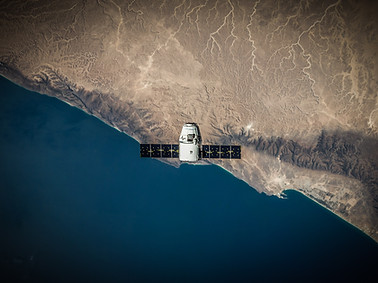
Satellite Communications
THE BENEFITS OF SATELLITE COMMUNICATIONS TO THE UK ECONOMY
Satellite communications complement terrestrial infrastructure-based communications to provide ubiquitous connectivity and are essential to a wide range of private and public sectors activities providing an unrivalled level of coverage, availability, resilience, and confidentiality. Satcoms represent over 60% of the whole UK space industry and contributes directly over £10 billion to the UK economy with a 3.3% share of the global space economy. It has proven to be resilient to economic cycles steadily growing in revenues, staff, and number of companies.

Direct to Home (DTH) broadcasting continues by far to drive the major share of revenues £ 7.5 bn and to employ the largest number of staff. The remaining is split between the supply of devices and equipment (£ 1.6bn) and fixed and mobile communications services (£ 1 bn) .
Close to one fifth of inputs are provided by UK non-space sector companies, another quarter by UK space sector suppliers while the remaining from overseas. The sector is characterised by high added value jobs and a skilled workforce: its high level of productivity estimated to be 2.6x the UK’s average labour productivity.
The advancement in technology and the development of high throughput satellites and constellations are opening growth opportunities for communications services and a new generation of user equipment. Significantly more capacity than that available in-orbit is being deployed by operators to provide high speed connectivity for fixed/mobile applications that need more capable and cheaper user terminals.
Cheaper and faster communications are an enabler for economic growth. Satcoms allow to bridge the digital divide connecting places not economically convenient to reach with terrestrial communications.

APPLICATIONS

Smartphones and data traffic growth have made mobile network connectivity even more essential, but the rollout of fiber to connect base stations is not a justifiable investment in non-densely populated areas.
Satcoms allow to connect even the most remote base station, cost effectively on a permanent basis or temporarily on an as needed basis for special events. Satellite can directly connect the content source to the edge content delivery node of a mobile network optimizing network and content delivery costs as well as improving network scalability.
Broadband underserved areas are common in any country. Satellite broadband allows to reach the goal to connect all household in a country with fast internet. Geostationary high-throughput satellites and constellations close the gap providing broadband with performance and price points comparable with fiber.
DID YOU KNOW?
UK is home to three satellite operators Inmarsat, Avanti and OneWeb. Inmarsat, set up over forty year ago as an intergovernmental organization, provides global mobile satellite communications for maritime and aviation safety. Avanti is a pioneer in the deployment of high-throughput connectivity in EMEA. OneWeb kickstarted the new wave of mega-constellations in low Earth orbit.
The migration to 5G, which incorporates multiple access technologies, foresees satellite as a key enabler to deliver the always connected vision

COSTS

Satcom connectivity has been available at a price premium. Advancements in technology are allowing to significantly reduce the cost per unit of capacity in the order of 10X. Operators are looking to more capable and flexible satellite architectures to optimize the cost of connectivity. Satcoms are becoming more competitive with further margin for improvement.
Depending on the application, user terminals cost has its importance for service adoption. Terminal technology development is ongoing with progress in cost and performance.
THE FUTURE
Satcoms are experiencing an unprecedented period of disruptive innovation with sustained investment from established players and new entrants. Further advances in technology and increased satcoms competitiveness together with the integration into 5G to deliver ubiquitous seamless connectivity will drive significant growth

